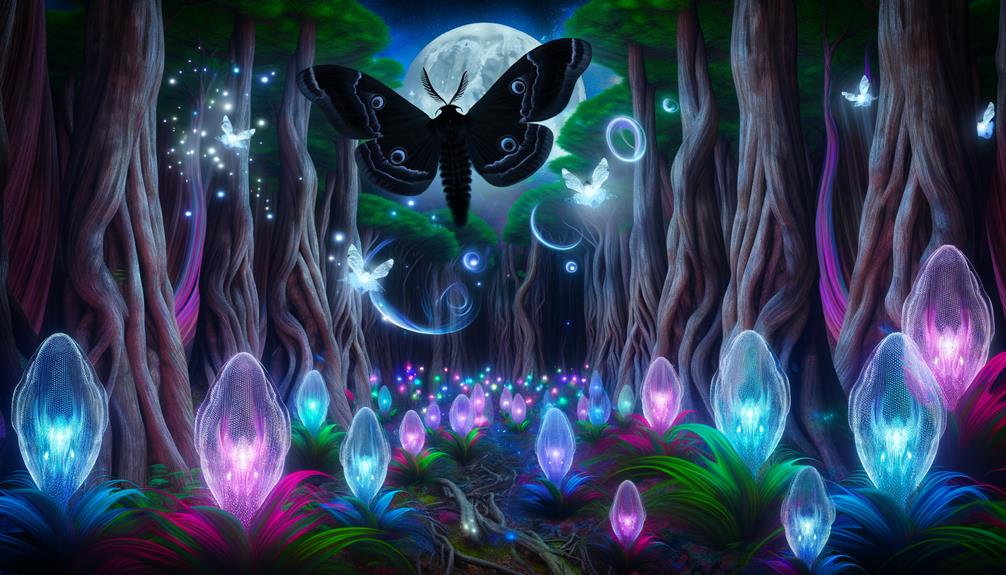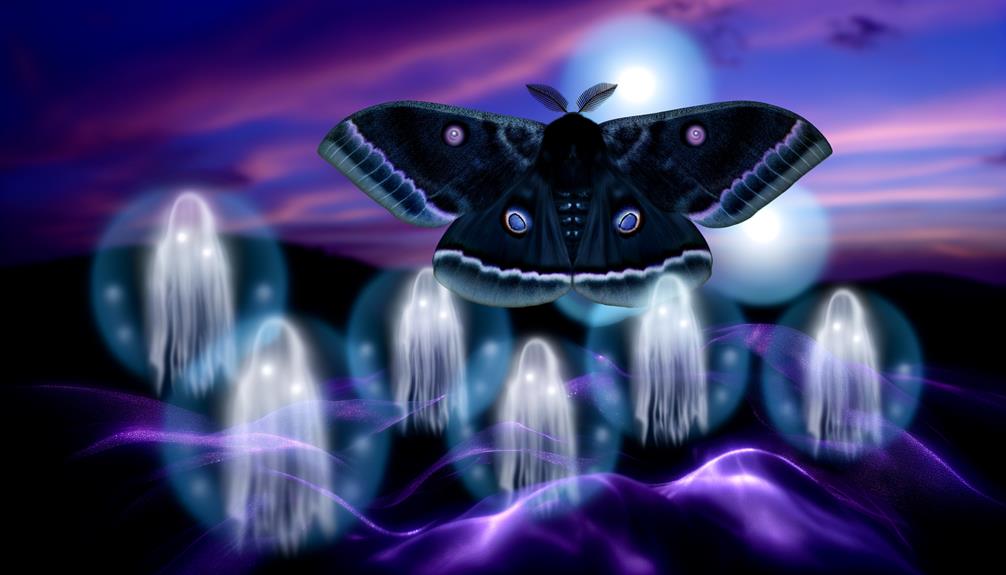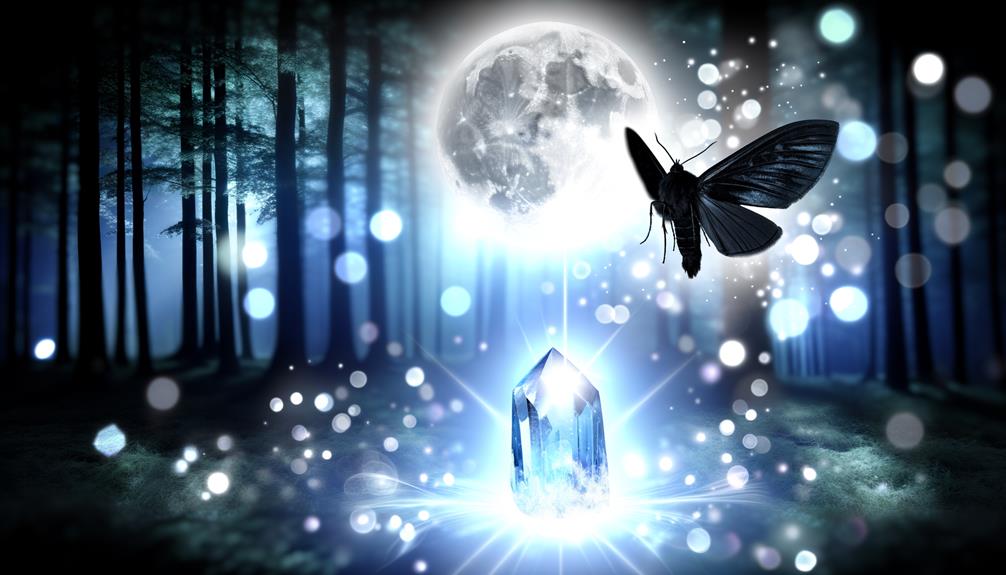Black Witch Moth Spiritual Meaning: Transformation
The Black Witch Moth carries deep spiritual meanings that differ across cultures. In Mexican folklore, it is seen as an omen of death, while Hawaiian traditions view it as a visiting spirit of a deceased loved one, offering solace.
Caribbean beliefs oscillate between seeing it as a harbinger of doom and a spiritual guide. This creature often symbolizes transformation, rebirth, and the connection between the physical and spiritual domains.
The moth’s varied interpretations reflect broader cultural attitudes towards mortality and the supernatural. Exploring diverse perspectives will further illuminate its complex symbolism and multifaceted roles.

Black Witch Moth Spiritual Meaning: Omens, Mystery, and Spiritual Transition
| Symbol | Spiritual Meaning | Description |
|---|---|---|
| 🦉 Nocturnal Nature | Hidden Wisdom | Represents secrets, intuition, and messages from the spirit world |
| ⚫ Dark Wings | Transformation & Death | Symbolizes endings, transitions, and spiritual evolution |
| 🪶 Silent Flight | Subtle Change | Indicates quiet, unnoticed shifts in your spiritual journey |
| 👁️ Sudden Appearance | Spiritual Warning | Often seen as an omen or signal of change from beyond |
| 🌌 Cultural Beliefs | Soul Messenger | In many traditions, it’s thought to carry the souls of the departed |
Symbolism in Various Cultures

The Black Witch Moth holds varied symbolic meanings across different cultures, often intertwining themes of death, transformation, and mystery.
In Mexican folklore, it is known as ‘Mariposa de la Muerte,’ symbolizing an omen of death. Conversely, in Hawaiian culture, the moth is seen as a manifestation of a deceased loved one returning for a visit, implying a more comforting connotation.
Caribbean folklore also shares this ambivalence, where the moth could either be a harbinger of doom or a spiritual messenger.
Analytical comparisons reveal a pattern: while the Black Witch Moth consistently embodies death and the unknown, its interpretation swings between foreboding and benign, shaped by cultural contexts and local beliefs.
This complex symbolism invites deeper inquiry into cultural perceptions of death and the afterlife.
Transformation and Rebirth
The Black Witch Moth stands as a potent symbol of transformation and rebirth, mirroring the profound changes inherent in the natural world.
This moth’s life cycle embodies the concept of embracing new beginnings, much like the metamorphosis seen in other transformative symbols such as the butterfly.
When considered within the context of overcoming past challenges, the Black Witch Moth serves as a reminder of resilience and the continuous journey of personal growth.
Symbol of Change
Often regarded as a powerful emblem of transformation and rebirth, the Black Witch Moth symbolizes significant changes and new beginnings in various cultural and spiritual contexts.
In Mesoamerican traditions, this moth is seen as a harbinger of profound shifts, often linked to death and subsequent rebirth. Comparatively, in Caribbean folklore, it is perceived as a manifestation of departed souls, hinting at a spiritual metamorphosis.
Analyzing these interpretations, the Black Witch Moth’s presence is frequently associated with the end of one phase and the dawn of another.
This symbolic representation underscores a universal theme: the cyclical nature of life, where endings pave the way for renewal and growth, affirming the moth’s role as a potent symbol of change.
Embracing New Beginnings
In the context of spiritual symbolism, embracing new beginnings through transformation and rebirth is vividly encapsulated in the life cycle of the Black Witch Moth. This nocturnal creature undergoes metamorphosis, evolving from caterpillar to winged adult, symbolizing profound personal evolution.
Comparative to the Phoenix’s fiery rebirth in mythology, the Black Witch Moth’s emergence represents renewal and the dawn of new opportunities. Contextually, this transformation underscores resilience and adaptability, urging individuals to embrace change as a natural, enriching process.
The moth’s dark, velvety wings further signify the mysterious and often unseen potential within every new beginning, encouraging a deeper understanding of cyclical growth. Embracing these elements can inspire a more enriching, transformative life experience.
Overcoming Past Challenges
Through the Black Witch Moth’s journey, one can find a compelling allegory for overcoming past challenges, as its metamorphosis embodies the essence of transformation and rebirth. This emblematic process serves as a reminder that adversity can catalyze profound personal growth.
When comparing the moth’s life cycle to human experiences, several key themes emerge:
- Resilience: Like the moth, individuals must endure hardships to achieve growth.
- Adaptation: The moth’s ability to adapt to various environments suggests the importance of flexibility in facing challenges.
- Renewal: Each stage of the moth’s life signifies a new beginning, paralleling human opportunities for reinvention.
These motifs underscore the transformational journey inherent in overcoming past difficulties.
Death and the Afterlife

The Black Witch Moth‘s association with death and the afterlife varies greatly across different cultures, offering a rich tapestry of symbolic interpretations.
In some traditions, it is seen as an omen of death, while in others, it represents the soul’s transformation and rebirth beyond the physical domain.
These contrasting perspectives highlight how cultural contexts shape the moth’s spiritual significance, linking it to broader themes of mortality and transcendence.
Symbolism in Various Cultures
Various cultures have long associated the black witch moth with themes of death and the afterlife, imbuing this nocturnal creature with rich symbolic significance.
For instance, in Mexican folklore, the moth is considered an omen of death, often appearing before someone passes away.
Conversely, Hawaiian traditions view it as a manifestation of a deceased loved one’s spirit.
In the Caribbean, the moth is linked to the soul’s journey to the afterlife.
Additionally, in parts of Texas and the American Southwest, it is seen as a harbinger of bad luck.
These varied interpretations highlight the moth’s powerful symbolism across different regions.
Transformation and Rebirth
Transformation and rebirth, often symbolized by the black witch moth, are themes intricately woven into the fabric of many spiritual beliefs, particularly those concerning death and the afterlife.
This enigmatic creature is perceived as a harbinger of change, representing the cyclical nature of life and the inevitability of transformation. Various cultures interpret the moth’s appearance as a sign of imminent rebirth or a soul’s journey beyond the mortal domain. The table below illustrates differing cultural perspectives:
| Culture | Interpretation |
|---|---|
| Mexican | Messenger of death and transformation |
| Caribbean | Symbol of a lost soul or spirit |
| Native American | Emblem of change and new beginnings |
These beliefs underscore the moth’s role as a powerful symbol in understanding life’s perpetual cycle.
Protection and Guidance
In many cultures, the Black Witch Moth is regarded as a powerful symbol of protection and guidance, often acting as a spiritual guardian during times of change. This nocturnal creature is believed to offer a unique form of support, steering individuals through life’s uncertainties.
The following aspects highlight its symbolic significance:
- Spiritual Guardian: Acts as a protector against negative energies and misfortunes.
- Guidance in Darkness: Represents finding direction during challenging periods.
- Transformation Support: Assists in steering personal growth and transformation.
Comparatively, the Black Witch Moth’s role in spiritual protection parallels other cultural symbols like the owl or raven, which also signify wisdom and guidance.
Omens and Superstitions

The Black Witch Moth is often enveloped in a shroud of omens and superstitions, with its presence interpreted differently across various cultures and historical periods.
In Mexican folklore, its appearance is often seen as a harbinger of death, while in the Caribbean, it is associated with malevolent witchcraft.
Conversely, Hawaiian traditions consider the moth a symbol of a departed loved one’s spirit visiting from the afterlife.
Contextually, these interpretations reflect broader cultural attitudes toward death and the supernatural.
Comparatively, while some societies view the moth with trepidation, others see it as a benign, even comforting figure.
This dichotomy illustrates the complex interplay between natural phenomena and cultural beliefs, shaping our understanding of the Black Witch Moth’s spiritual significance.
Connection to the Spirit World
Across various cultures, the Black Witch Moth is frequently perceived as a conduit between the physical and spiritual spheres, symbolizing a profound connection to the spirit world. This belief manifests through various interpretations:
- Ancient Traditions: Some indigenous communities view the moth as a harbinger of messages from ancestors.
- Shamanistic Practices: Shamans often regard the moth as a guide during spiritual journeys, aiding in communication with the ethereal domain.
- Symbolic Representation: In folklore, the moth is seen as a symbol of transformation and the soul’s journey after death.
These perspectives illustrate the moth’s complex role in connecting the living with the spiritual sphere.
Interpreting Personal Encounters

Many individuals interpret encounters with the Black Witch Moth through a personal lens, often influenced by their cultural, spiritual, and psychological contexts.
For some, the moth symbolizes transformation and the embrace of the unknown, reminiscent of the moth’s nocturnal nature.
In various cultures, such as Mexican and Jamaican, it may signify death or an omen, reflecting deep-seated beliefs and folklore.
Psychologically, these interpretations can manifest as projections of inner fears or aspirations.
Comparatively, while one person may perceive a Black Witch Moth as a harbinger of change, another might view it as a protective spirit.
The variability of these interpretations underscores the complex interplay between individual experiences and broader cultural narratives, highlighting the moth’s multifaceted spiritual significance.
Conclusion
The black witch moth is a tapestry woven with threads of symbolism, spanning diverse cultures and beliefs. This enigmatic creature embodies themes of transformation, rebirth, and connection to the afterlife, serving as both a harbinger of omens and a guardian of spiritual domains.
Its presence, often cloaked in superstition, invites a deeper contemplation of the unseen forces guiding human existence. Like a shadow in the moonlight, the black witch moth flits between worlds, bridging the mortal and the mystical.






